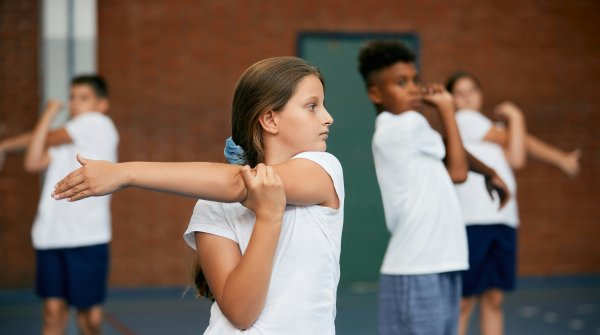
The more variety to its activities and experiences, the better. Jumping, running, climbing, playing tag, balancing or cycling are all on the program until the age of eight. When children enter elementary school, they are ready to learn a sport and join a sports club. They enjoy learning new techniques and competing with others. This physical activity benefits child development.
Development of bones und muscles
Strong Bones: At birth, children’s skeletons are not yet fully developed in terms of solid bone substance. Bones are made up of substitute cartilaginous tissue. While children grow up solid bone structure begins to deposit. This development is based on genetics, whereas physical activity endorses this process. The more movement, the more robust and denser the bone structure.
Strong Muscles: Babies already have a complete set of muscles, though not all of them work properly yet. The muscles for gripping and sucking function immediately, other muscles, such as those for lifting the head, develop bit by bit. Too little activity and too much sitting around impede the proper development of the musculature.
Improved Coordination: In order to develop body and spatial awareness the entire body must move. Swinging, spinning or jumping provides the child with awareness of its body, the location of its arms and legs within a space, and a sense of balance.
Improved Posture: The s-shape of the spine develops within the first six years of life. In order for the musculoskeletal system to develop properly it requires a lot of exercise. Otherwise the spine will be unable to straighten up properly. Bad spinal posture is almost impossible to correct at an adult age.
Better Brains: A baby is born with 100 billion nerve cells. They only work once they are connected. Activity of the senses and physical movements generate impulses, which support the creation of synapses: each movement, each perception, each experience creates a new nerve connection in the brain. Physical activity and intellectual development are indelibly connected. Motoric development is a prerequisite for mental development.
Good motoric improves self-confidence
Strong Sense of Self: A child develops a feeling for its own abilities with the help of active experiences. It discovers that its actions create a reaction. The experience of success and failure, performance potential and its limits provide the child with a sense of confidence and independence.
Good Health: Lack of physical activity and an unhealthy diet cause corpulence; an appropriate level of activity, on the other hand, keep children healthy. Kids who spend a lot of time outside each day thus strengthen their immune system and are rarely sick. Chubby kids have to deal with more than one issue: they are frequently shunned by their peers and often suffer from diabetes, high blood pressure or cardiovascular diseases.
- ISPO awards
- Mountain sports
- Bike
- Design
- Retail
- Fitness
- Health
- ISPO Job Market
- ISPO Munich
- ISPO Shanghai
- Running
- Brands
- Sustainability
- Olympia
- OutDoor
- Promotion
- Sports Business
- ISPO Textrends
- Triathlon
- Water sports
- Winter sports
- eSports
- SportsTech
- OutDoor by ISPO
- Heroes
- Transformation
- Sport Fashion
- Urban Culture
- Challenges of a CEO
- Trade fairs
- Sports
- Find the Balance
- Product reviews
- Newsletter Exclusive Area
- Magazine






